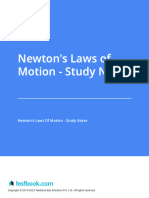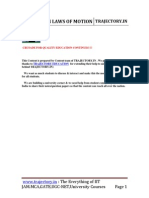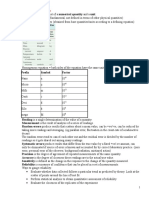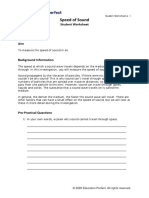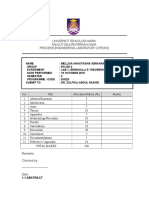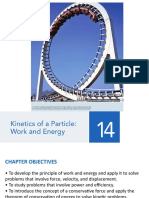Laws of Motion
Laws of Motion
Uploaded by
nikharramnaniCopyright:
Available Formats
Laws of Motion
Laws of Motion
Uploaded by
nikharramnaniCopyright
Available Formats
Share this document
Did you find this document useful?
Is this content inappropriate?
Copyright:
Available Formats
Laws of Motion
Laws of Motion
Uploaded by
nikharramnaniCopyright:
Available Formats
One Stop for Colleges Education Career
Covers complete IITJEE/AIEEE syllabus Lessons, tests by IIT/NIT toppers Chemistry, Maths and Physics Sections 1000+ Questions and Sample tests Last minute preparation and help Its Free
Minglebox Engineering Prep
Free Online Preparation for Engineering with Minglebox Engineering Prep. Cover basic concepts of under Section for Engineering Entrance Exam Preparation with Study material, solved examples and tests prepared by IIT/NIT toppers.
Minglebox Engineering Prep
Minglebox.com
Laws of Motion
Aristotles view that a force is necessary to keep a body in uniform motion is wrong. A force is necessary in practice to counter the opposing force of friction.
Galileo extrapolated simple observations on motion of bodies on inclined planes, and arrived at the law of inertia. Newtons first law of motion is the same law rephrased thus: Everybody continues to be in its state of rest or of uniform motion in a straight line, unless compelled by some external force to act otherwise.
In simple terms, the First Law is If external force on a body is zero, its acceleration is zero. Momentum (p ) of a body is the product of its mass (m) and velocity (v) : p=mv
Minglebox Engineering Prep
Minglebox.com
Newtons second law of motion : The rate of change of momentum of a body is proportional to the applied force and takes place in the direction in which the force acts. Thus F = k (dp/dt) = k ma where F is the net external force on the body and a its acceleration. We set the constant of proportionality k = 1 in S.I. Then F = dp/dt = ma The SI unit of force is newton: 1 N = 1 kg m s-2. o The second law is consistent with the First Law (F = 0 implies a = 0) o It is a vector equation o It is applicable to a particle, and also to a body or a system of particles, provided F is the total external force on the system and a is the acceleration of the system as a whole.
Minglebox Engineering Prep
Minglebox.com
o F at a point at a certain instant determines a at the same point at that instant. That is the Second Law is a local law; a at an instant does not depend on the history of motion.
Impulse is the product of force and time which equals change in momentum. The notion of impulse is useful when a large force acts for a short time to produce a measurable change in momentum. Since the time of action of the force is very short, one can assume that there is no appreciable change in the position of the body during the action of the impulsive force. Newtons third law of motion: To every action, there is always an equal and opposite reaction. In simple terms, the law can be stated thus :Forces in nature always occur between pairs of bodies. Force on a body A by bodyB is equal and opposite to the force on the body B by A.Action and reaction forces are simultaneous forces. There is no cause-effectrelation between action and reaction. Any of the two mutual forces can becalled action and the other reaction. Action and reaction act on differentbodies and so they cannot be cancelled out. The internal action and reactionforces between different parts of a body do, however, sum to zero.
Minglebox Engineering Prep
Minglebox.com
Law of Conservation of Momentum The total momentum of an isolated system of particles is conserved. The lawfollows from the second and third law of motion. Friction Frictional force opposes (impending or actual) relative motion between twosurfaces in contact. It is the component of the contact force along the commontangent to the surface in contact. Static friction fs opposes impending relativemotion; kinetic friction fk opposes actual relative motion. They are independentof the area of contact and satisfy the following approximate laws:
fs (fs)max = sR fk = kR s (co-efficient of static friction) and k (co-efficient of kinetic friction) are constants characteristic of the pair of
surfaces in contact. It is found experimentally that k is less than s.
Minglebox Engineering Prep
Minglebox.com
Sample Examples
Determine the maximumacceleration of the train in which a boxlying on its floor will remain stationary, given that the co-efficient of static frictionbetween the box and the trains floor is0.15.
Solution
Since the acceleration of the box is dueto the static friction,
ma = fs s N = s m g
i.e. a s g amax = s g = 0.15 x 10 m s2 = 1.5 m s2
Minglebox Engineering Prep
Minglebox.com
A bullet of mass 0.04 kg moving with a speed of 90 ms-1 enters aheavy wooden block and is stopped after a distance of 60 cm. What is the averageresistive force exerted by the block on thebullet?
Solution a = - u2/2s = - 90 * 90/2*0.6 = 6750 ms-2 The retarding force, by the Second Law ofmotion, is = 0.04 kg x 6750 m s-2 = 270 N
Minglebox Engineering Prep
Minglebox.com
You might also like
- Sound Waves and Echoes: Pages 226-227Document1 pageSound Waves and Echoes: Pages 226-227varshatarateNo ratings yet
- 04 - Fundamentals of Physics - Naghi GasimovDocument17 pages04 - Fundamentals of Physics - Naghi GasimovKVP LyricsNo ratings yet
- 04 Newtons Laws of MotionDocument20 pages04 Newtons Laws of MotionOjeaga FavourNo ratings yet
- Newton's_Laws_of_Motion_-_Study_NotesDocument11 pagesNewton's_Laws_of_Motion_-_Study_Notesabiswas189251No ratings yet
- Common Forces in MechanicsDocument11 pagesCommon Forces in Mechanicsjustin cletusNo ratings yet
- Newton Laws of Motion: Trajectory - inDocument10 pagesNewton Laws of Motion: Trajectory - inpriyanka429No ratings yet
- Hsslive - Plus One Chapter 4 - 2024Document19 pagesHsslive - Plus One Chapter 4 - 2024Pranavi MuthusamyNo ratings yet
- Module 2 DynamicsDocument47 pagesModule 2 DynamicsTaha Kafil-HussainNo ratings yet
- Newtons Second Law CapeDocument33 pagesNewtons Second Law CapeTanieka PowellNo ratings yet
- 3rd ChapterDocument11 pages3rd ChapterMushfiqur RahmanNo ratings yet
- Newton's Laws of MotionDocument8 pagesNewton's Laws of MotionVincent JosephNo ratings yet
- Newton's Laws of MotionDocument13 pagesNewton's Laws of MotionChinmay SharmaNo ratings yet
- PHY101 Laws of MotionDocument4 pagesPHY101 Laws of Motionfarouk jiyaNo ratings yet
- Laws of Motion Class 11 Notes NEET 2023 Physics - Free PDF DownloadDocument22 pagesLaws of Motion Class 11 Notes NEET 2023 Physics - Free PDF Downloadayushdangi5635No ratings yet
- HelpfulDocument18 pagesHelpfulcigila6437No ratings yet
- Newtons Laws of Motion - UnlockedDocument11 pagesNewtons Laws of Motion - UnlockedmadjerkmemesNo ratings yet
- Newton'S Laws Newton's Laws of Motion Are Three: Philosophiae Naturalis Principia MathematicaDocument1 pageNewton'S Laws Newton's Laws of Motion Are Three: Philosophiae Naturalis Principia MathematicaKusuma MahadikaNo ratings yet
- CBSE Class 11 Physics Notes - Laws of MotionDocument18 pagesCBSE Class 11 Physics Notes - Laws of Motionmailme41210% (1)
- Newton's Law Note Physics IB HLDocument4 pagesNewton's Law Note Physics IB HLsupergirl123No ratings yet
- General Physics L4Document4 pagesGeneral Physics L4Ronan CanavanNo ratings yet
- Lesson-5 1Document39 pagesLesson-5 1Precious MeniaNo ratings yet
- Newton's Laws of MotionDocument8 pagesNewton's Laws of MotionRoda Gayle RañadaNo ratings yet
- Newtons 1 and 2 Law: ST NDDocument15 pagesNewtons 1 and 2 Law: ST NDApoorva TalankiNo ratings yet
- Case Study Questions Class 11 Physics - Laws of MotionDocument9 pagesCase Study Questions Class 11 Physics - Laws of MotionRavinder Kumar50% (2)
- Lesson 5 Newtons Law of MotionsDocument32 pagesLesson 5 Newtons Law of MotionsPrecious MeniaNo ratings yet
- Laws of Motion: InertiaDocument5 pagesLaws of Motion: InertiaSubhashakti BeheraNo ratings yet
- Class XI: Physics Chapter 4: Laws of Motion Chapter Notes Key LearningDocument4 pagesClass XI: Physics Chapter 4: Laws of Motion Chapter Notes Key Learning99anandsrivastava100% (1)
- Chapter 1 Mechanics - Newton's Laws of MotionDocument2 pagesChapter 1 Mechanics - Newton's Laws of Motiontekeje7802No ratings yet
- Lecture 5 - FBDsDocument24 pagesLecture 5 - FBDsjunedrkaziNo ratings yet
- Lecture 10Document4 pagesLecture 10Ayam MasNo ratings yet
- Phy BWDocument14 pagesPhy BWsasasa785236No ratings yet
- Physics CH - 3Document49 pagesPhysics CH - 3Prasanna VijayakumarNo ratings yet
- About: 4.2 Describe Contact and Non-Contact Force, Mass and WeightDocument6 pagesAbout: 4.2 Describe Contact and Non-Contact Force, Mass and WeightNanzkie Andrei SamanNo ratings yet
- Physics DefinitionsDocument15 pagesPhysics DefinitionsprintdaddyNo ratings yet
- Newton's Laws of Motion - Wikipedia, The Free EncyclopediaDocument13 pagesNewton's Laws of Motion - Wikipedia, The Free EncyclopediabmxengineeringNo ratings yet
- Lec 5 GS& A-1Document17 pagesLec 5 GS& A-1adullahr45456No ratings yet
- Class 11 Physics Revision Notes Law of MotionDocument17 pagesClass 11 Physics Revision Notes Law of MotionThulasinathNo ratings yet
- Linear Momentum and Newton's Second LawDocument17 pagesLinear Momentum and Newton's Second LawSeijuro AkashiNo ratings yet
- Physics Module Week 7 and 8 V4 2024Document23 pagesPhysics Module Week 7 and 8 V4 2024JR BandelariaNo ratings yet
- Law of Conservation of MomentumDocument4 pagesLaw of Conservation of MomentumMartha Glorie Manalo WallisNo ratings yet
- Engineering MechanicsDocument6 pagesEngineering MechanicsShackled AstraNo ratings yet
- Center of Mass, Momentum, Impulse and Collision: Learning CompetenciesDocument7 pagesCenter of Mass, Momentum, Impulse and Collision: Learning CompetenciesNathalie SerafinNo ratings yet
- PhysicsDocument274 pagesPhysicsRohit SinghNo ratings yet
- Focus PointsDocument9 pagesFocus Pointsshradhasharma2101No ratings yet
- 2 DynamicsDocument73 pages2 DynamicsEdwin HuangNo ratings yet
- Impulse and MomentumDocument17 pagesImpulse and Momentumaljohnbondad121521No ratings yet
- CBSE Class 9 Science Chapter 9 Force and Laws of Motion Revision NotesDocument14 pagesCBSE Class 9 Science Chapter 9 Force and Laws of Motion Revision NotesBriti DubeyNo ratings yet
- Laws of Motion NotesDocument13 pagesLaws of Motion NotesTejas SinghNo ratings yet
- Conservation of Momentum PPP 1213361160074257 8Document74 pagesConservation of Momentum PPP 1213361160074257 8Mohd Sabri NorNo ratings yet
- Strength of Materials: "Force, Type of Force and Free Body Diagram For Force"Document9 pagesStrength of Materials: "Force, Type of Force and Free Body Diagram For Force"Lulav BarwaryNo ratings yet
- Module: Newton'S Law of Motion 1: ND ST ST NDDocument14 pagesModule: Newton'S Law of Motion 1: ND ST ST NDGreen BrainNo ratings yet
- Newton's Laws of Motion: From Wikipedia, The Free EncyclopediaDocument33 pagesNewton's Laws of Motion: From Wikipedia, The Free EncyclopediaWiwik AnjajariNo ratings yet
- Kinetics of Particles 2Document17 pagesKinetics of Particles 2Rezwan IslamNo ratings yet
- E101 - AgustinDocument21 pagesE101 - AgustinSeth Jarl G. AgustinNo ratings yet
- Newton'S Laws of Motion: 1 ForceDocument5 pagesNewton'S Laws of Motion: 1 ForceCharl CuaNo ratings yet
- Newton's Laws of Motion: Free Body DiagramsDocument37 pagesNewton's Laws of Motion: Free Body DiagramsawbNo ratings yet
- Newton's Laws of Motion: TheoryDocument6 pagesNewton's Laws of Motion: TheoryEarl averzosaNo ratings yet
- PHYSICS 11TH GUESS AND IMPORTANT QUESTIONS FOR JKBOSE2025Document15 pagesPHYSICS 11TH GUESS AND IMPORTANT QUESTIONS FOR JKBOSE2025b87479006No ratings yet
- Newston's Laws of MotionDocument4 pagesNewston's Laws of MotionkenNo ratings yet
- Idealization in MechanicsDocument2 pagesIdealization in MechanicsReashma Ps40% (5)
- Grade 11 Exam Papers.Document13 pagesGrade 11 Exam Papers.Nomteeh KhumaloNo ratings yet
- LM Q4 Science G9 W2Document4 pagesLM Q4 Science G9 W2donamia quintanNo ratings yet
- Curvilinear Motion: General & Rectangular Components: Today's ObjectivesDocument19 pagesCurvilinear Motion: General & Rectangular Components: Today's ObjectivesAtef NazNo ratings yet
- Mechanics Worksheet 3 G 11 Mar 21Document6 pagesMechanics Worksheet 3 G 11 Mar 21rajvir singhNo ratings yet
- Hydraulic Machinery: UG-CE-Session-2018 Spring-2020Document10 pagesHydraulic Machinery: UG-CE-Session-2018 Spring-2020Salman100% (1)
- Class IX: Science Chapter 2: Force and Laws of Motion Chapter NotesDocument2 pagesClass IX: Science Chapter 2: Force and Laws of Motion Chapter NotesGKJK2530No ratings yet
- Cambridge International Advanced Subsidiary and Advanced LevelDocument16 pagesCambridge International Advanced Subsidiary and Advanced Levelcharlene junusNo ratings yet
- Scientiae Educatia: Jurnal Pendidikan SainsDocument1 pageScientiae Educatia: Jurnal Pendidikan SainsEki ValentinoNo ratings yet
- Practical MYP 4 Speed of SoundDocument6 pagesPractical MYP 4 Speed of SoundPrasanna PatilNo ratings yet
- Basics of Reentry Vehicle Flight DynamicsDocument65 pagesBasics of Reentry Vehicle Flight DynamicsMatthew AustinNo ratings yet
- Edm and Total StationDocument32 pagesEdm and Total StationlinusdreokokonNo ratings yet
- Bernouli S Theorem DemonstrationDocument14 pagesBernouli S Theorem DemonstrationHarris ImranNo ratings yet
- 300 Important Questions in PhysicsDocument43 pages300 Important Questions in PhysicsDhrutvan Reddy ReddiwaryNo ratings yet
- Chapter 13 - GearsDocument38 pagesChapter 13 - Gearsalmosawi 17No ratings yet
- Oscillations: Manish S. Lokur Xi, Kendriya Vidyalaya DharwadDocument33 pagesOscillations: Manish S. Lokur Xi, Kendriya Vidyalaya Dharwadmanish2443687No ratings yet
- Kelompok 8: 1.muhammad Alfian Amirullah 2.ahmad Alamsyah 3.nurmadinah 4.amalia DuapadangDocument3 pagesKelompok 8: 1.muhammad Alfian Amirullah 2.ahmad Alamsyah 3.nurmadinah 4.amalia DuapadangDodi SaputraNo ratings yet
- Work Power Energy Master MindDocument22 pagesWork Power Energy Master MindADITYA SinghNo ratings yet
- Lecture 2 SM Winter 2021Document21 pagesLecture 2 SM Winter 2021Yaseen NaasNo ratings yet
- ch2 ProbsDocument40 pagesch2 ProbsDeywin Tineo MedinaNo ratings yet
- Physics Chapter 1 - WavesDocument13 pagesPhysics Chapter 1 - WavesChew Han HoongNo ratings yet
- Physics Qs and MsDocument33 pagesPhysics Qs and MsFatma OsmanNo ratings yet
- 14.kinetics of A Particle Work and EnergyDocument11 pages14.kinetics of A Particle Work and EnergyrodyNo ratings yet
- Engineering Physics 15phy12 NotesDocument131 pagesEngineering Physics 15phy12 NotesHarsha K J0% (1)
- Forces and Their EffectsDocument24 pagesForces and Their EffectsLee TeckBee50% (2)
- Experiment 5: College Physics LabDocument12 pagesExperiment 5: College Physics LabPatrick SapieraNo ratings yet
- Dynamics of Nelson RotorDocument8 pagesDynamics of Nelson RotorsowgNo ratings yet
- The Technique of The Eggbeater KickDocument18 pagesThe Technique of The Eggbeater KickalokNo ratings yet
- IGCSE Topical Past Papers Physics P4 C9 - C10Document48 pagesIGCSE Topical Past Papers Physics P4 C9 - C10kenias ndunaNo ratings yet
- Physics 11th Test 10Document4 pagesPhysics 11th Test 10Hassan Ali Bhutta0% (1)



